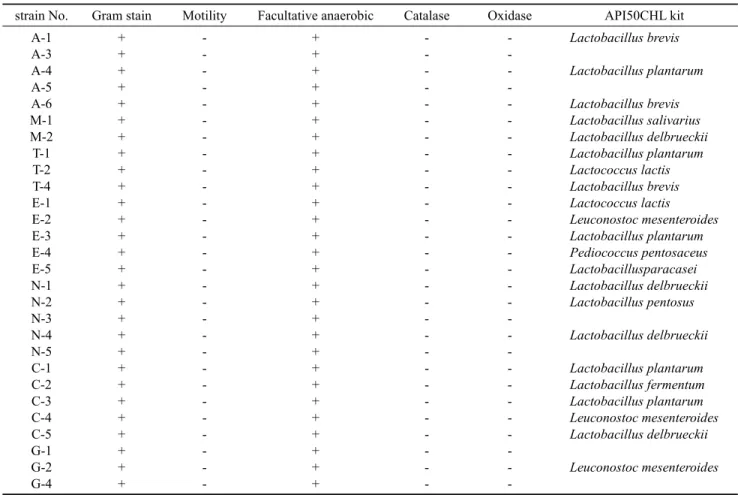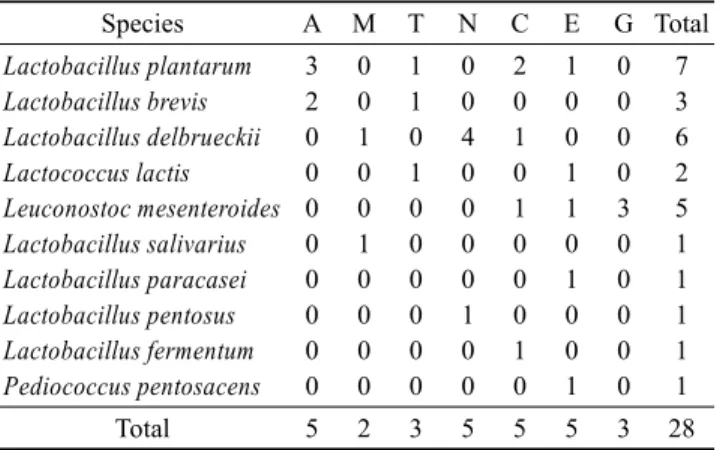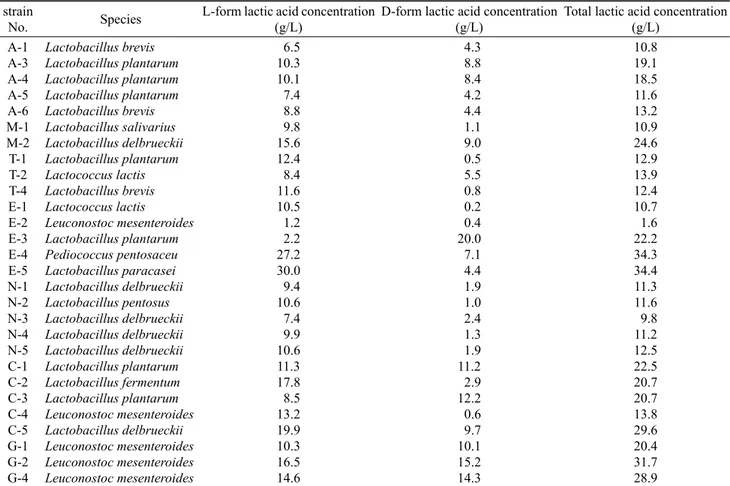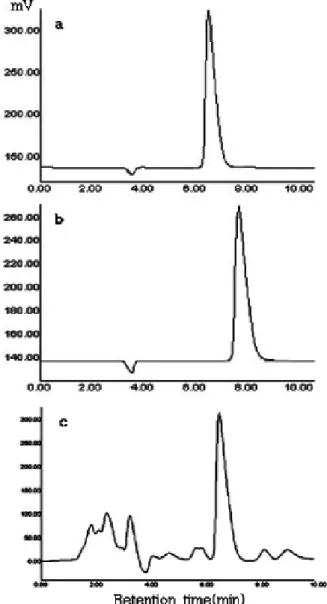연구논문
패류로부터 젖산 세균의 분리 및 특성
강창호1, 정호건1, 구자룡1, 전은진1, 곽대영1, 홍채환2, 김시환2, 서지연2, 한도석2, 소재성1*
Identification and Characteristics of Lactic Acid Bacteria Isolated from Shellfishes
Chang-Ho Kang1, Ho Geon Jeong1, Ja-Ryong Koo1, Eun Jin Jeon1, Dae Yung Kwak1, Chae Hwan Hong2, Si Hwan Kim2, Ji Yeon Seo2, Do Suck Han2 and Jae-Seong So1*
접수: 2012년 3월 13일 / 게재승인: 2012년 5월 17일
© 2012 The Korean Society for Biotechnology and Bioengineering
Abstract:
1)Lactic acid is an important product arising from the anaerobic fermentation by lactic acid bacteria (LAB). It is used in the pharmaceutical, cosmetic, chemical, and food industries as well as for biodegradable polymer and green solvent production. The poly lactic acid (PLA) is an important material for bio-plastic manufacturing process. For PLA production by new LAB, we screened LAB isolates from shellfish. A total of 28 LAB were isolated from various shellfishes. They were all Gram positive, oxidase and catalase negative. Based on API 50CHL kit, 7 strains among the 28 isolates were identified as Lactobacillus plantarum, 6 strains as Lactobacillus delbrueckii, 5 strains as Leuconostocmesenteroides, 3 strains as Lactobacillus brevis, 2 strains as Lactococcus lactis, 1 strain as Lactobacillus salivarius, 1 strain
as Lactobacillus paracasei, 1 strain as Lactobacillus pentosus, 1 strain as Lactobacillus fermentum and 1 strain asPediococcus pentosaceu. Also, we examined the amount
of total lactic acid produced by these new strains by HPLC analysis with Chiralpak MA column. One strain E-3 fromMytilus edulis was indentified as Lactobacillus plantarum
1인하대학교 생물공학과
1Department of Biological Engineering, College of Engineering, Inha University, Incheon 402-751, Korea
Tel: +82-32-860-7516, Fax: +82-32-872-4046 e-mail: sjaeseon@inha.ac.kr
2현대자동차 중앙연구소 기반기술연구팀
2Central Research Institute, Hyundai Motors, Uiwang, Gyeonggi, Korea
and found to produce 20.0 g/L of D-form lactic acid from 20 g/L of dextrose. Further studies are underway to increase the D-lactic acid production by E-3.
Keywords: lactic acid bacteria (LAB), poly lactic acid (PLA),
isolation, identification, D-form1. 서론
젖산 (lactic acid)은 L형, D형, DL형의 이성질체가 있으 며, 음료의 산미제, 주류발효 초기의 부패방지제, 화장품 등으로 다양하게 이용되고 있는 중요한 화학 물질이다. 젖산 은 화학적 전환기술로 Poly lactic acid (PLA) 중합 중간체 인 락타이드 (Lactide)나 아크릴산 (Acrylic acid) 등의 유용 화학물질로 변환된다 [1]. L형 젖산과 D형 젖산을 같이 사용 한 경우, 폴리 유산의 융점이 높아지고, 결정화도 증가되는 현상을 보여 결과적으로 소재의 높은 열안정성 확보가 가능 하게 되었다 [2]. L형 젖산의 경우 식품산업에서 대부분의 응용분야에 사용되기에 많은 연구가 이루어져 있는 반면, D형 유산의 경우 응용성이 낮아 연구가 거의 이루어지지 않았다. D형 젖산을 생산하는 연구 방법 중 최근 부각되고 있는 방법으로는 자연계에서 젖산을 과량으로 생산하는 자 연균주 (Lactobacillus spp. 등)를 선발하여 생산하는 방법 이 있다. 이 방식으로 접근할 경우 젖산균의 특성상 수율, 생산성 면에서 우수한 것으로 알려져 있다. Kimura 연구 팀의 연구 결과 [3]에 따르면 Lactobacillus delbrueckii와
Sporolactobacillus inulinus를 이용하면 발효 반응으로 생산
strain No. Gram stain Motility Facultative anaerobic Catalase Oxidase API50CHL kit A-1
A-3 A-4 A-5 A-6 M-1 M-2 T-1 T-2 T-4 E-1 E-2 E-3 E-4 E-5 N-1 N-2 N-3 N-4 N-5 C-1 C-2 C-3 C-4 C-5 G-1 G-2 G-4
+ + + + + + + + + + + + + + + + + + + + + + + + + + + +
- - - - - - - - - - - - - - - - - - - - - - - - - - - -
+ + + + + + + + + + + + + + + + + + + + + + + + + + + +
- - - - - - - - - - - - - - - - - - - - - - - - - - - -
- - - - - - - - - - - - - - - - - - - - - - - - - - - -
Lactobacillus brevis Lactobacillus plantarum Lactobacillus brevis Lactobacillus salivarius Lactobacillus delbrueckii Lactobacillus plantarum Lactococcus lactis Lactobacillus brevis Lactococcus lactis Leuconostoc mesenteroides Lactobacillus plantarum Pediococcus pentosaceus Lactobacillusparacasei Lactobacillus delbrueckii Lactobacillus pentosus Lactobacillus delbrueckii Lactobacillus plantarum Lactobacillus fermentum Lactobacillus plantarum Leuconostoc mesenteroides Lactobacillus delbrueckii Leuconostoc mesenteroides
A: Isolated from Arca avellana Lamarck, M: Isolated from Mactra veneriformis Reeve, T: Isolated from Tapes phillipinarum, N: Isolated from Neptunea arthritica cumingi, C: Isolated from Turbo cornutus, E: Isolated from Mytilus edulis, G: Isolated from Crassostrea gigas +, growth; -, no growth.
Data are from triplicate experiments.
Table 1.Some morphological and biochemical characteristics of lactic acid bacteria from shellfishes
된 젖산 중 D형 젖산의 함유량이 98%이상의 고순도로 나타 나는 것을 확인할 수 있었다.
젖산균은 혐기적 또는 통성 혐기성으로 증식하는 그람 양 성 세균으로, 자연계에 널리 분포되어있는 미생물이다. 전통 적으로 다양한 발효식품에 이용되어 왔고, 일반적으로 안전 하다고 인식되는 미생물 (GRAS, generally recognized as safe)로서 [4], Bergey’s Manual [5]에서는 그람양성 구균 과 그람양성 간균에서 다루고 있다. Catalase 음성으로 포자 를 형성하지 않고, 혐기성 병원성 균주의 생장을 억제하기 위해 다양한 억제물질들을 생산하며, 글루코오즈 대사과정 에서 생산된 젖산을 통해 낮은 pH을 유지하는 것으로 알 려져 있다 [6]. 기존의 젖산을 생산하는 균주의 분리는 김 치 등 식음료에서 분리하여 상업적으로 사용되었다 [7,8].
Leuconostoc과 Lactobacillus vulgaricus등은 D형 젖산을 주
로 생산하며, Bacillus, Rhizopus, Streptococcus, Enterococcus 의 미생물은 L형 젖산을 생산하는 것으로 알려져 있다 [7].PLA 합성의 경우 pH와 온도 등 다양한 환경 스트레스에 강한 젖산생산 균주가 요구된다. Lee의 연구결과 [9]에 따르 면, 패류인 굴에서 분리한 Lactobacillus spp.가 다양한 환경 스트레스에 내성이 높은 것을 확인할 수 있었다.
이에 본 연구에서는 패류에서 분리한 젖산균의 젖산생산 관련 연구가 전무한 바, 다양한 패류에서 젖산균을 분리 ․ 동 정하여 발효과정에서 생산되는 L형과 D형의 젖산 생산량과 총 젖산 생산량을 확인해 보았다. 이를 통해 환경 스트레스 내성이 높은 D형 젖산생산 균주를 선별하여 PLA 연구의 기초 자료로 이용하고자 한다.
2. 재료 및 방법
2.1. 배지 및 시약
패류에서 젖산균의 분리를 위하여 Rogosa SL media와 0.1%
bromocresol purple (BCP)이 첨가된 Lactobacilli MRS media 는 Difco사 (MI, USA) 제품을 사용하였고, 계대배양에는 MRS media를 사용하였다. 균주의 보존을 위하여 균배양액 에 glycerol이 25%(v/v)가 되도록 조성하여 -70℃에서 보관 하며 실험에 사용하였다. 분리한 균주의 생화학적 특성 검 사를 위해서는 Gram stain sets는 Difco사 (MI, USA) 제품, oxidase reagent는 Sigma-Aldrich사 (MO, USA) 제품, API 50 CHL kit는 BioMerieux사 (France) 제품을 사용하였다.
2.2. 균주의 분리
2011년 7월부터 12월까지 인천 서해안의 양식어장에서 채취 한 패류 (돌조개, 동죽, 바지락, 갈색띠매물고둥, 소라, 진주 담치, 굴)를 냉장상태를 유지하면서 실험실로 운반하여 균주 분리 실험을 진행하였다. 패류시료 중 패각이 손상되지 않 은 것을 골라 멸균된 칼로 내용물을 200 g이 될 때까지 탈 각하여, 멸균된 비커에 넣은 후 phosphate buffered saline (PBS; 2.5 mM KH2PO4, pH 7.2) 200 mL를 부어 혼합한다.
혼합 후에 멸균된 blending cup에 넣어 blender (7011S, Waring, Torrington, CT)를 이용하여 90초 (low speed 30 s, high speed 60 s)동안 갈아준다. PBS로 10-1-10-2까지희석한 용액 100 μL를 Rogosa 고체배지에 도말한 후, CO2치환하 여 37℃에서 2일간 배양한다. 생성된 콜로니는 0.1% BCP 가 들어있는 MRS 평판배지에 배양하여 동정용 균주로 사용 하였다. 순수 분리된 균주는 MRS액체 배지에서 배양한 후 25% glycerol로 조성하여 -70℃에서 보관하며 동정과 생화 학적 특성 시험에 사용하였다.
2.3. 분리균주의 동정
분리된 균주는 MRS 액체배지에서 37℃로 24시간 배양한 후 그람염색 [10]을 실시하여 위상차 현미경으로 형태학적 특성을 관찰하였다. 또한 분리한 균주의 생화학적 특성을 조사하기 위하여, A Laboratory Method in Food and Dairy Microbiology [11]와 The Prokaryotes [12]의 방법을 참고 하여 실험을 실시하였다. Catalase test는 배양 평판에 3%
hydrogen peroxide (H2O2)를 첨가한 후 O2 발생 유무를 관찰 하였고, oxidase test는 콜로니를 비금속성 막대를 사용하여 슬라이드에 올려놓고 Kovac’s reagent를 한 방울 떨어뜨려 변색여부를 관찰하였다. 최초 분리한 28균주의 동정을 위하 여 API 50CHL kit을 사용하여 배지의 색변화를 관찰한 후, API web program (http://apiweb.biomerieux.com, Biomerieux) 을 이용하여 동정하였다. D형 젖산을 가장 많이 생산하는 균주는 추가적으로 16S rRNA gene sequencing을 이용하 여 분자 동정하였다.
2.4. HPLC를 이용한 젖산 생산량 분석
분리된 28종의 균주는 MRS 액체배지 5 mL에서 48시간 동 안 정치 배양한 후, 배양액을 0.2 μm filter (Minisart, Satorius) 를 사용하여 필터링하여 HPLC (Younglin, Korea)를 통해 L형과 D형의 젖산 생산량과 총 젖산 생산량을 분석하였다.
분석에 사용된 컬럼은 ChiralpakRMA (reverse phase type, 4.6 × 50 mm), 이동상으로는 2 mM CuSO4를 0.5 mL/min의 유속으로 이용하였고, UV 검출기로 254 nm에서 검출하였 으며, 시료 주입량은 0.02 mL였다.
3. 결과 및 고찰
3.1. 패류에서 유산균 분리
인천 서해안에서 양식되는 돌조개 (Arca avellana Lamarck A), 동죽 (Mactra veneriformis Reeve M), 바지락 (Tapes
phillipinarum T), 갈색띠매물고둥 (Neptunea arthritica cumingi N), 소라 (Turbo cornutus C), 진주담치 (Mytilus edulis E), 굴 (Crassostrea gigas G) 등 총 6종에서 분리한
28개의 분리 균주에 대해서 형태학적 및 생리 화학적 특성 을 조사하였다. 그람염색을 실시하여 위상차 현미경으로 관 찰한 결과, 모든 분리 균주들이 그람양성으로 나타났다. 분리 균주에 대한 여러 가지 형태학적 및 생리 화학적 특성을 조 사한 결과는 Table 2에서 보여주는 바와 같다. 분리 균주 모두에서 catalase와 oxidase는 음성이었고, BCP가 들어있 는 MRS배지에서 산을 생산하여 생성된 콜로니 주변이 노란 색으로 변하는 등 젖산균의 일반적인 특징과 잘 일치하였다.Table 2. Species distribution of lactic acid bacteria isolated randomly
from shellfishesSpecies A M T N C E G Total
Lactobacillus plantarum Lactobacillus brevis Lactobacillus delbrueckii Lactococcus lactis Leuconostoc mesenteroides Lactobacillus salivarius Lactobacillus paracasei Lactobacillus pentosus Lactobacillus fermentum Pediococcus pentosacens
3 2 0 0 0 0 0 0 0 0
0 0 1 0 0 1 0 0 0 0
1 1 0 1 0 0 0 0 0 0
0 0 4 0 0 0 0 1 0 0
2 0 1 0 1 0 0 0 1 0
1 0 0 1 1 0 1 0 0 1
0 0 0 0 3 0 0 0 0 0
7 3 6 2 5 1 1 1 1 1
Total 5 2 3 5 5 5 3 28
A: Isolated from Arca avellana Lamarck, M: Isolated from Mactra
veneriformis Reeve, T: Isolated from Tapes phillipinarum, N: Isolated
from Neptunea arthritica cumingi, C: Isolated from Turbo cornutus, E: Isolated from Mytilus edulis, G: Isolated from Crassostrea gigas.3.2. 분리 균주의 동정
분리한 28종의 균주에 대하여 API 50CHL Kit을 이용한 실험 결과를 웹 프로그램을 통해 동정한 결과는 Table 1에 나타 내었다. 총 28개의 균주 중 A-3, 4, 5, T-1, E-3, C-1, 3의 7개 균주가
Lactobacillus plantarum으로 동정되었고, M-2, N-1,
3, 4, 5, C-5의 6개 균주가 Lactobacillus delbrueckii, E-2, G-1, 2, 4, C-4의 5개 균주가 Leuconostoc mesenteroides, A-1, 6, T-4의 3개 균주가 Lactobacillus brevis, T-2, E-1의 2개 균주가 Lactococcus lactis로 동정되었다. 그 외에는 E-4는Pediococcus pentosaceu, E-5는 Lactobacillus paracasei,
N-2는 Lactobacillus pentosus, M-1은 Lactobacillus salivarius, C-2는 Lactobacillus fermentum으로 각각 동정되었다. 28개 의 균주 중 D형 젖산을 가장 많이 생산하는 E-3 균주의 경우 16S rRNA gene sequencing을 이용하여 추가 동정결과, API 50CHL Kit와 같이 L. plantarum으로 재확인 하였다.3.3. 패류에서의 젖산균 종 (species)의 분포
패류에서 분리한 젖산균 28종을 동정한 결과를 토대로 하여 패류에서의 주요 젖산균의 종 분포를 살펴본 결과는 Table 2 에 나타내었다. 돌조개에서 분리한 5주 중 Lactobacillus
brevis 2주, Lactobacillus plantarum 3주가 동정되었다. 진
strain
No. Species L-form lactic acid concentration
(g/L) D-form lactic acid concentration
(g/L) Total lactic acid concentration (g/L)
A-1 A-3 A-4 A-5 A-6 M-1 M-2 T-1 T-2 T-4 E-1 E-2 E-3 E-4 E-5 N-1 N-2 N-3 N-4 N-5 C-1 C-2 C-3 C-4 C-5 G-1 G-2 G-4
Lactobacillus brevis Lactobacillus plantarum Lactobacillus plantarum Lactobacillus plantarum Lactobacillus brevis Lactobacillus salivarius Lactobacillus delbrueckii Lactobacillus plantarum Lactococcus lactis Lactobacillus brevis Lactococcus lactis Leuconostoc mesenteroides Lactobacillus plantarum Pediococcus pentosaceu Lactobacillus paracasei Lactobacillus delbrueckii Lactobacillus pentosus Lactobacillus delbrueckii Lactobacillus delbrueckii Lactobacillus delbrueckii Lactobacillus plantarum Lactobacillus fermentum Lactobacillus plantarum Leuconostoc mesenteroides Lactobacillus delbrueckii Leuconostoc mesenteroides Leuconostoc mesenteroides Leuconostoc mesenteroides
6.5 10.3 10.1 7.4 8.8 9.8 15.6 12.4 8.4 11.6 10.5 1.2 2.2 27.2 30.0 9.4 10.6 7.4 9.9 10.6 11.3 17.8 8.5 13.2 19.9 10.3 16.5 14.6
4.3 8.8 8.4 4.2 4.4 1.1 9.0 0.5 5.5 0.8 0.2 0.4 20.0 7.1 4.4 1.9 1.0 2.4 1.3 1.9 11.2 2.9 12.2 0.6 9.7 10.1 15.2 14.3
10.8 19.1 18.5 11.6 13.2 10.9 24.6 12.9 13.9 12.4 10.7 1.6 22.2 34.3 34.4 11.3 11.6 9.8 11.2 12.5 22.5 20.7 20.7 13.8 29.6 20.4 31.7 28.9
A: Isolated from Arca avellana Lamarck, M: Isolated from Mactra veneriformis Reeve, T: Isolated from Tapes phillipinarum, N: Isolated from Neptunea arthritica cumingi, C: Isolated from Turbo cornutus, E: Isolated from Mytilus edulis, G: Isolated from Crassostrea gigas.
Table 3. Lactic acid productivities with lactic acid bacteria from shellfishes
주담치에서 분리한 5주는 각각 1주씩 Lactococcus lactis,
Leuconostoc mesenteroides, Lactobacillus plantarum, Pediococcus pentosaceu, Lactobacillus paracasei로 동정
되었다. 갈색띠매물고둥에서 분리한 5주 중 Lactobacillusdelbrueckii 4주 , Lactobacillus pentosus 1주가 동정되
었다. 동죽에서 분리한 2주는 Lactobacillus salivarius,Lactobacillus delbrueckii로 동정되었다. 바지락에서 분리
한 3주는 Lactobacillus plantarum, Lactococcus lactis,Lactobacillus brevis로 동정되었다. 소라에서 분리한 5주 중 Lactobacillus plantarum 2주, Lactobacillus fermentum, Leuconostoc mesenteroides, Lactobacillus delbrueckii가
각각 1주씩 동정되었다. 그리고 굴에서 분리한 3주는 모두Leuconostoc mesenteroides로 동정되었다. Lee [9]의 연구
결과를 보면, 굴에서 분리한 젖산균의 분포에서 Lactobacillusparacasei가 가장 많았으며 , Lactobacillus plantarum, Lactobacillus pentosus, Lactobacillus johnsonii등이 분포
하는 것을 확인할 수 있었다.3.4. HPLC에 의한 총 젖산 생산량 확인
동정된 28주의 젖산균을 MRS 배지에서 배양하여, 대사물질 로 배양액에서 생산되는 총 젖산량과 젖산의 형태별 생산량 을 확인해 보았다 (Table 3). 총 젖산생산량을 종별로 보면,
Lactobacillus plantarum에 속하는 7주는 11.6-22.5 g/L,
Lactobacillus delbrueckii에 속하는 6주는 9.8-29.6 g/L,
Lactobacillus brevis에 속하는 3주는 10.8-13.2 g/L, Leuconostoc
mesenteroides에 속하는 5주는 1.6-31.7 g/L, Lactococcus
lactis인 2주는 10.7-13.9 g/L의 젖산을 생산하는 것을 확인
할 수 있었다. Fu [13]의 연구결과를 보면, Lactobacillusplantarum은 37℃, pH 6에서 15-25시간 발효 후에 총 젖산
이 10-12 g/L, Stenroos [14]의 연구에서는 Lactobacillusdelbrueckii가 20시간 발효 후 L형의 젖산을 12 g/L, Garde
[15]의 연구에서는 Lactobacillus brevis와 Lactobacilluspentosus에서 각각 19.0 g/L, 11.5 g/L의 젖산을 생산하는 것
으로 알려져 있다. Lactobacillus salivarius, Pediococcuspentosaceu, Lactobacillus paracasei, Lactobacillus fermentum,
Lactobacillus pentosus로 동정된 균주들은 각각 10.9 g/L,
34.3 g/L, 34.4 g/L, 20.7 g/L, 11.6 g/L의 생산량을 나타냈으 며, 대부분 L형의 젖산을 생산하고 있었다. Ko [7]의 연구 에서 시판김치에서 분리 및 동정 된 젖산균의 젖산생산 형태 를 보면, Lactobacillus plantarum, Lactobacillus casei에서는 L형의 젖산, Leuconostoc lactis, Leuconostoc mesenteroides 에서는 D형의 젖산을 주로 생산하는 것으로 알려져 있으 며, Sung [16]의 연구결과에서 Lactobacillus delbrueckii,Lactococcus lactis, Lactobacillus casei, Leuconostoc
mesenteroides에서 D형 젖산이 주로 생산되는 것으로 알려
져 있다. 본 연구에서 패류로부터 분리 ․ 동정된 젖산균의 경우 균주에 따라서 차이가 있기는 하지만, 기존에 알려져 있던 젖산 생산량보다 많이 생산하는 균주들을 확인할 수 있 었다. 28개의 균주 중 Lactobacillus plantarum으로 동정된 E-3 균주의 경우 D형 젖산을 20.0 g/L를 생산하여, 28개 의 균주 중 D형 젖산 생산량이 가장 많았다 (Fig. 1). 또한Leuconostoc mesenteroides으로 동정된 G-1, 2, 4의 3주는
D형 젖산이 10.1-15.2 g/L로 L형 젖산과 비슷한 생산량을 보이는 것을 확인할 수 있었다.Fig. 1. Determination of the configuration of Lactic acid converted
from pyruvate using HPLC equipped with a chiral column. (a) Standard sample of D-form lactic acid, (b) standard sample of L-form lactic acid, (c) D-form lactic acid production from E-3.본 연구를 통해 자연계인 패류에서 젖산균을 분리하는 방 법과 젖산의 형태별 생산량의 확인 결과자료는 차후 PLA의 기초 연구에 참고자료로 활용되길 기대하며, 지속적으로 자연계에서의 젖산균의 분리를 진행하도록 할 것이다.
4. 결론
패류로부터 젖산을 생산하는 자연균주를 분리 ․ 동정하고, HPLC를 통해 생산되는 젖산량을 확인하고자 하였다. 분리 된 균주는 MRS 배지에서 배양되었으며, 형태학적 관찰 및 생화학적 특성을 조사하였으며, API 50CHL kit를 통해 균 주를 동정하였다. 분리된 28개의 균주를 동정한 결과, 7개 균주가
Lactobacillus plantarum, 6개 균주가 Lactobacillus delbrueckii, 5개 균주가 Leuconostoc mesenteroides, 3개
균주가Lactobacillus brevis, 2개 균주가 Lactococcus lactis로 동정되었다. 그 외에 Pediococcus pentosaceu, Lactobacillus paracasei, Lactobacillus pentosus, Lactobacillus salivarius, Lactobacillus fermentum으로 각각 1 균주씩 동정
되었다. 동정된 28균주를 배양하여 생산되는 젖산의 형태 및 젖산 생산량을 확인해 본 결과, 균주에 따라 차이가 있지 만 1.6-34.4 g/L의 젖산을 생산하는 것을 확인하였다. 28균 주 대부분은 L형의 젖산을 주로 생산하였으며, Lactobacillusplantarum으로 동정된 E-3 균주의 경우 D형 젖산을 20.0 g/L를
생산하여 D형 젖산 생산량이 가장 많았다. 또한 Leuconostocmesenteroides으로 동정된 G-1, 2, 4의 3주는 D형 젖산이 10.1-
15.2 g/L로 L형 젖산과 비슷한 생산량을 보이는 것을 확인 할 수 있었다.차후 본 연구에서 D형 젖산을 주로 생산하는 진주담치에 서 분리된 E-3균주에 대해 분자유적학적인 방법으로 젖산의 생산에 관여하는 lactate dehydrogenase (LDH) 유전자의 과발현을 진행하며, DL형의 젖산을 생산하는 굴에서 분리된 G-1, 2, 4의 3균주에 대해서는 L형 젖산을 발현하는 유전자 의 knock-out을 통해 D형 젖산의 생산량과 순도가 증가되 는 것을 확인해 볼 것이다.
감사
본 논문은 (주)현대엔지비와 인하대학교의 지원에 의하여 연구되었음.
References
1. Korea Biotechnology Industry Organization. Bio-product Market and Bio Technical Development Trend. http://www.koreabio.org.
(2010).
2. Ikada, Y., K. Jamshidi, H. Tsuji, and S. H. Hyon (1991) Stereocomplex formation between enantiomeric poly (lactides).
Macromolecules. 20: 904-906.
3. Fukushima, K., K. Sogo, S. Miura, and Y. Kimura (2004) Production of D-lactic acid by bacterial fermentation of rice starch. Macromol. Biosci. 4: 1021-1027.
4. Sandine, W. E., K. S. Muralidhara, P. R. Elliker, and D. C.
England (1972) Lactic acid bacteria in food and health: a review with special reference to enteropathogenic Escherichia
coli as well as certain enteric diseases and their treatment with
antibiotics and lactobacilli. J. Milk Food Technol. 35: 691-702.5. Gilliland, S. E. (1990) Health and nutritional benefits from
lactic acid bacteria. FEMS Microbiol. Lett. 87: 175-188.
6. Barbers, C. and S. Boris (2006) Benson’s Microbiological Applications (General microbiology, complete version). 10th ed., pp. 251-289. McGraw-Hill College, NY, USA.
7. Ko, J. L., C. K. Oh, M. C. Oh, and S. H. Kim (2009) Isolation and Identification of Lactic Acid Bacteria from Commercial
Kimchi. J. Korean Soc. Food Sci. Nutr. 38: 732-741
8. Kim, S. Y., J. D. Kim, J. S. Son, S. K. Lee, K. J. Park, and M.
S. Park (2011) Biochemical and molecular identification of antibacterial lactic acid bacteria isolated from kimchi. Korean
J. Food Sci. Technol. 43: 446-452.
9. Lee, H. I., M. H. Kim, K. Y. Kim, J. S. So (2010) Screening and selection of stress-resistant Lactobacillus spp. isolated from the marine oyster (Crassostrea gigas). Anaerobe. 16: 522-526.
10. Gerhardt, P., R. G. E. Murray, W. A. Wood, and N. R. Krieg (1994)
Methods for general and Molecular Bacteriology. pp. 31-32.
American Society for Microbiology, Washington DC, USA.
11. Cappuccino, J. G. and N. Sherman (1987) Biochemical activities
of microorganisms. In A Laboratory Methods in Food and
Dairy Microbiology. 2nd ed., pp. 125. The Benjamin Cummings
Publishing Company, California, USA.12. Rouff, K. L. (1992) The genus Streptococcus. In The Prokaryotes.
2nd ed., pp. 1450. Springer-Verlag, NY, USA.
13. Fu, W., and A. P. Mathews (1999) Lactic acid production from lactose by Lactobacillus plantarum: kinetic model and effects of pH, substrate, and oxygen. Biochem Eng. J. 3: 163-170.
14. Stenroos, S. L., Y. Y. Linko, and P. Linko (1982) Production of L-lactic acid with immobilized Lactobacillus delbrueckii.
Biotechnol. Lett. 4: 159-164.
15. Garde, A., G. Jonsson, A. S. Schmidt, and B. K. Ahring (2002) Lactic acid production from wheat straw hemicellulose hydrolysate by Lactobacillus pentosus and Lactobacillus brevis. Bioresource
Technol. 81: 217-223.
16. Sung, H. G. (1999) Isolation · identification and characterization



